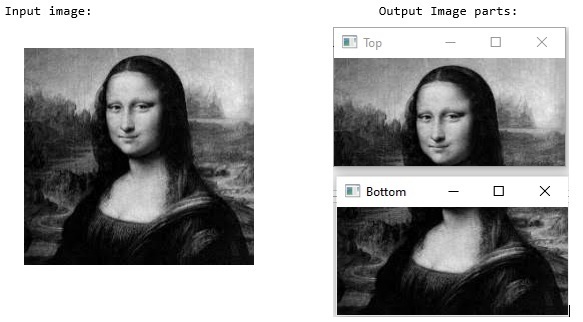
 Data Structure
Data Structure Networking
Networking RDBMS
RDBMS Operating System
Operating System Java
Java MS Excel
MS Excel iOS
iOS HTML
HTML CSS
CSS Android
Android Python
Python C Programming
C Programming C++
C++ C#
C# MongoDB
MongoDB MySQL
MySQL Javascript
Javascript PHP
PHP
- Selected Reading
- UPSC IAS Exams Notes
- Developer's Best Practices
- Questions and Answers
- Effective Resume Writing
- HR Interview Questions
- Computer Glossary
- Who is Who
Dividing Images Into Equal Parts Using OpenCV Python
The Python OpenCV library enables us to utilize a variety of image-processing tools, like image classification, face/object detection, tracking, and more.
In this article, we will use python list slicing or numpy array slicing techniques to divide an image into equal parts, since OpenCV-python uses the Numpy array to store the image data/pixel values.
Input Output Scenarios
Assuming we have an input image and in the output, we will see the equally divide parts of the given image.

Approach
We will follow the below steps to divide the images into equal parts.
Load the image.
Extract the image dimensions and store them in a variable.
Divide the image array using the python slicing technique.
Finally save the segregated parts.
Example
In this example, we will horizontally divide the input image "cat.jpg" into 2 parts.
import cv2
image= cv2.imread('Images/cat.jpg')
height, width, channels = image.shape
half_height = height//2
top_section = image[:half_height, :]
bottom_section = image[half_height:, :]
cv2.imshow('Top', top_section)
cv2.imshow('Bottom', bottom_section)
cv2.waitKey(0)
Input Image

Output Images

Example
In this example, we will divide the input image "logo.png" into 4 equal parts.
import cv2
import numpy as np
def divide_img_blocks(img, n_blocks=(2,2)):
horizontal = np.array_split(img, n_blocks[0])
splitted_img = [np.array_split(block, n_blocks[1], axis=1) for block in horizontal]
return np.asarray(splitted_img, dtype=np.ndarray).reshape(n_blocks)
result = divide_img_blocks(cv2.imread('Images/logo.png'))
for i in range(result.shape[0]):
for j in range(result.shape[1]):
cv2.imwrite(f"Output Images/my_block_{i}_{j}.jpg", result[i,j])
Input Image

Output Images

Example
In this approach, we will divide the input image "Lenna.png" into 9 equal parts.
import cv2,time
img = cv2.imread('Images/Lenna.png')
img2 = img
height, width, channels = img.shape
# Number of pieces Horizontally
W_SIZE = 3
# Number of pieces Vertically to each Horizontal
H_SIZE = 3
for ih in range(H_SIZE ):
for iw in range(W_SIZE ):
x = width/W_SIZE * iw
y = height/H_SIZE * ih
h = (height / H_SIZE)
w = (width / W_SIZE )
print(x,y,h,w)
img = img[int(y):int(y+h), int(x):int(x+w)]
NAME = str(time.time())
cv2.imwrite("Output Images/" + str(ih)+str(iw) + ".png",img)
img = img2
Output
0.0 0.0 124.0 223.0 223.0 0.0 124.0 223.0 446.0 0.0 124.0 223.0 0.0 124.0 124.0 223.0 223.0 124.0 124.0 223.0 446.0 124.0 124.0 223.0 0.0 248.0 124.0 223.0 223.0 248.0 124.0 223.0 446.0 248.0 124.0 223.0
Input Image

Output Images

The above example, will divide the image first into 3 Horizontal pieces then for each of that 3 pieces it will crop another 3 images Leaving a total of 9 parts. Change the W_SIZE and H_SIZE value to adjust how many equal parts we need to divide the image.
In all the above examples, we have successfully divided the input images into equal parts.

